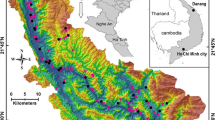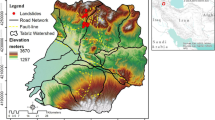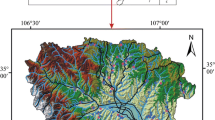Abstract
This study compared two soft computing methods that are applied to soft computation in assessment of earthquake-triggered landslide susceptibility: the support vector machine (SVM) and artificial neural networks (ANN). As a case study, a series of landslide susceptibility maps were constructed for the affected area of the 2013 Minxian-Zhangxian, Gansu Province, China Mw 5.9 earthquake. From data available, 2330 coseismic landslides were partitioned into two subsets which were used as a training dataset and a test dataset, respectively. In addition, other 1631 points on the map were randomly selected as non-landslide samples in those areas were not influenced by the coseismic landslides. Ten conditioning factors of landslides were considered, including elevation, relative relief, slope angle, slope aspect, slope curvature, slope position, lithology, peak ground acceleration (PGA), distance from the probable seismogenic fault, and distance along the fault. Using the ANN and SVM, ten landslide susceptibility maps were produced for the study area. Cross comparisons and validations of these ten resulting maps with real coseismic landslides show that the polynomial kernel type with a high enough polynomial degree term value (e.g., 5 or 6) of the SVM technology is most appropriate for coseismic landslide susceptibility assessment, which is a challenge to the previously held notion that the SVM method with radial basis function is the most suitable.












Similar content being viewed by others
References
Alkhasawneh MS, Ngah UK, Tay LT, Mat Isa NA, Al-batah MS (2013) Determination of important topographic factors for landslide mapping analysis using MLP network. Sci World J 2013:415023. doi:10.1155/2013/415023
Bai SB, Wang J, Lu GN, Zhou PG, Hou SS, Xu SN (2009) GIS-based and data-driven bivariate landslide-susceptibility mapping in the Three Gorges Area China. Pedosphere 19(1):14–20
Brenning A (2005) Spatial prediction models for landslide hazards: review, comparison and evaluation. Nat Hazards Earth Syst Sci 5(6):853–862
Bui DT, Pradhan B, Lofman O, Revhaug I, Dick OB (2012) Spatial prediction of landslide hazards in Hoa Binh province (Vietnam): a comparative assessment of the efficacy of evidential belief functions and fuzzy logic models. Catena 96:28–40
Caniani D, Pascale S, Sdao F, Sole A (2008) Neural networks and landslide susceptibility: a case study of the urban area of Potenza. Nat Hazards 45(1):55–72
Chen TC, Lin ML, Hung JJ (2003) Pseudostatic analysis of Tsao-Ling rockslide caused by Chi–Chi earthquake. Eng Geol 71(1–2):31–47
Cheng M-Y, Roy AFV, Chen K-L (2012) Evolutionary risk preference inference model using fuzzy support vector machine for road slope collapse prediction. Expert Syst Appl 39(2):1737–1746
Choi J, Oh HJ, Won JS, Lee S (2010) Validation of an artificial neural network model for landslide susceptibility mapping. Environ Earth Sci 60(3):473–483
Chousianitis K, Del Gaudio V, Kalogeras I, Ganas A (2014) Predictive model of Arias intensity and Newmark displacement for regional scale evaluation of earthquake-induced landslide hazard in Greece. Soil Dyn Earthq Eng 65:11–29
Dai FC, Lee CF, Li J, Xu ZW (2001) Assessment of landslide susceptibility on the natural terrain of Lantau Island. Hong Kong. Environ Geol 40(3):381–391
Dou J, Yamagishi H, Pourghasemi HR, Yunus AP, Song X, Xu Y, Zhu Z (2015) An integrated artificial neural network model for the landslide susceptibility assessment of Osado Island Japan. Nat Hazards 78(3):1749–1776
ENVI Software (2014) Support vector machine background. http://www.exelisvis.com/docs/BackgroundSVM.html. Accessed 1 Jun 2014
García-Rodríguez MJ, Malpica JA, Benito B, Díaz M (2008) Susceptibility assessment of earthquake-triggered landslides in El Salvador using logistic regression. Geomorphology 95(3–4):172–191
Garevski M, Zugic Z, Sesov V (2013) Advanced seismic slope stability analysis. Landslides 10(6):729–736
Gaudio VD, Pierri P, Wasowski J (2003) An approach to time-probabilistic evaluation of seismically induced landslide hazard. Bull Seismol Soc Am 93(2):557–569
Gorum T, Fan XM, van Westen CJ, Huang RQ, Xu Q, Tang C, Wang GH (2011) Distribution pattern of earthquake-induced landslides triggered by the 12 May 2008 Wenchuan earthquake. Geomorphology 133(3–4):152–167
Gupta V (2005) The relationship between tectonic stresses, joint patterns and landslides in the higher Indian Himalaya. J Nepal Geol Soc 31:51–58
He YP, Beighley RE (2008) GIS-based regional landslide susceptibility mapping: a case study in southern California. Earth Surf Proc Land 33(3):380–393
Hong H, Pradhan B, Xu C, Tien Bui D (2015) Spatial prediction of landslide hazard at the Yihuang area (China) using two-class kernel logistic regression, alternating decision tree and support vector machines. Catena 133:266–281
Jenness J, Brost B, Beier P (2013) Land facet corridor designer: topographic position index tools. http://www.jennessent.com. Accessed 1 Jun 2014
Jibson RW (1993) Predicting earthquake-induced landslide displacements using Newmark’s sliding block analysis. Transp Res Rec 1411:9–17
Kamp U, Growley BJ, Khattak GA, Owen LA (2008) GIS-based landslide susceptibility mapping for the 2005 Kashmir earthquake region. Geomorphology 101(4):631–642
Kavzoglu T, Sahin EK, Colkesen I (2014) Landslide susceptibility mapping using GIS-based multi-criteria decision analysis, support vector machines, and logistic regression. Landslides 11(3):425–439
Keefer DK (1984) Landslides caused by earthquakes. Geol Soc Am Bull 95(4):406–421
Lee S, Evangelista DG (2006) Earthquake-induced landslide-susceptibility mapping using an artificial neural network. Nat Hazards Earth Syst Sci 6(5):687–695
Lee S, Sambath T (2006) Landslide susceptibility mapping in the Damrei Romel area, Cambodia using frequency ratio and logistic regression models. Environ Geol 50(6):847–855
Li XZ, Kong JM (2014) Application of GA–SVM method with parameter optimization for landslide development prediction. Nat Hazards Earth Syst Sci 14(3):525–533
Liao HW, Lee CT (2000) Landslides triggered by the Chi–Chi earthquake. In: Proceedings of the 21st Asian Conference on Remote Sensing, Taipei 1–2:383–388
Marjanović M, Kovačević M, Bajat B, Voženílek V (2011) Landslide susceptibility assessment using SVM machine learning algorithm. Eng Geol 123(3):225–234
Miles SB (2011) Participatory model assessment of earthquake-induced landslide hazard models. Nat Hazards 56(3):749–766
Miles SB, Ho CL (1999) Rigorous landslide hazard zonation using Newmark’s method and stochastic ground motion simulation. Soil Dyn Earthq Eng 18(4):305–323
Nakasuji A (2011) Landslide hazard mapping during a large scale earthquake. J Mt Sci Engl 8(2):223–227
Newmark NM (1965) Effects of earthquakes on dams and embankments. Geotechnique 15(2):139–160
Pareek N, Sharma ML, Arora MK (2010) Impact of seismic factors on landslide susceptibility zonation: a case study in part of Indian Himalayas. Landslides 7(2):191–201
Polykretis C, Ferentinou M, Chalkias C (2015) A comparative study of landslide susceptibility mapping using landslide susceptibility index and artificial neural networks in the Krios River and Krathis River catchments (northern Peloponnesus, Greece). Bull Eng Geol Environ 74(1):27–45
Pourghasemi HR, Pradhan B, Gokceoglu C (2012a) Application of fuzzy logic and analytical hierarchy process (AHP) to landslide susceptibility mapping at Haraz watershed Iran. Nat Hazards 63(2):965–996
Pourghasemi HR, Mohammady M, Pradhan B (2012b) Landslide susceptibility mapping using index of entropy and conditional probability models in GIS: Safarood Basin Iran. Catena 97:71–84
Pourghasemi HR, Jirandeh A, Pradhan B, Xu C, Gokceoglu C (2013a) Landslide susceptibility mapping using support vector machine and GIS at the Golestan Province Iran. J Earth Syst Sci 122(2):349–369
Pourghasemi HR, Pradhan B, Gokceoglu C, Mohammadi M, Moradi HR (2013b) Application of weights-of-evidence and certainty factor models and their comparison in landslide susceptibility mapping at Haraz watershed Iran. Arab J Geosci 6(7):2351–2365
Pourghasemi HR, Moradi HR, Aghda SMF (2013c) Landslide susceptibility mapping by binary logistic regression, analytical hierarchy process, and statistical index models and assessment of their performances. Nat Hazards 69(1):749–779
Pradhan B (2013) A comparative study on the predictive ability of the decision tree, support vector machine and neuro-fuzzy models in landslide susceptibility mapping using GIS. Comput Geosci 51:350–365
Pradhan B, Lee S (2010) Landslide susceptibility assessment and factor effect analysis: backpropagation artificial neural networks and their comparison with frequency ratio and bivariate logistic regression modelling. Environ Model Softw 25(6):747–759
San BT (2014) An evaluation of SVM using polygon-based random sampling in landslide susceptibility mapping: the Candir catchment area (western Antalya, Turkey). Int J Appl Earth Obs Geoinf 26:399–412
Umar Z, Pradhan B, Ahmad A, Jebur MN, Tehrany MS (2014) Earthquake induced landslide susceptibility mapping using an integrated ensemble frequency ratio and logistic regression models in West Sumatera Province, Indonesia. Catena 118:124–135
US Geological Survey (2013) Shakemap usb000ije3, USGS ShakeMap: Gansu, China (Instrumental Intensity). Map Version 4 http://earthquake.usgs.gov/earthquakes/shakemap/global/shake/b000ije3/download/shape.zip. Accessed 1 Aug 2013
Vapnik VN (1995) The nature of statistical learning theory. Springer, New York
Wang WN, Nakamura H, Tsuchiya S, Chen CC (2002) Distributions of landslides triggered by the Chi–chi Earthquake in Central Taiwan on September 21, 1999. Landslides J Jpn Landslide Soc 38(4):318–326
Wu XL, Ren F, Niu RQ (2014) Landslide susceptibility assessment using object mapping units, decision tree, and support vector machine models in the Three Gorges of China. Environ Earth Sci 71(11):4725–4738
Xu C, Xu XW (2012) The 2010 Yushu earthquake triggered landslides spatial prediction models based on several kernel function types. Chin J Geophys 55(9):2994–3005
Xu C, Xu XW (2014) Statistical analysis of landslides caused by the Mw 6.9 Yushu, China, earthquake of April 14, 2010. Nat Hazards 72(2):871–893
Xu C, Xu XW, Dai FC, Xiao JZ, Tan XB, Yuan RM (2012a) Landslide hazard mapping using GIS and weight of evidence model in Qingshui River watershed of 2008 Wenchuan earthquake struck region. J Earth Sci 23(1):97–120
Xu C, Dai FC, Xu XW, Lee YH (2012b) GIS-based support vector machine modeling of earthquake-triggered landslide susceptibility in the Jianjiang River watershed, China. Geomorphology 145–146:70–80
Xu C, Xu XW, Dai FC, Saraf AK (2012c) Comparison of different models for susceptibility mapping of earthquake triggered landslides related with the 2008 Wenchuan earthquake in China. Comput Geosci 46:317–329
Xu C, Xu X, Yao Q, Wang Y (2013a) GIS-based bivariate statistical modelling for earthquake-triggered landslides susceptibility mapping related to the 2008 Wenchuan earthquake China. Q J Eng Geol Hydrog 46(2):221–236
Xu C, Xu XW, Dai FC, Wu ZD, He HL, Wu XY, Xu SN, Shi F (2013b) Application of an incomplete landslide inventory, logistic regression model and its validation for landslide susceptibility mapping related to the May 12, 2008 Wenchuan earthquake of China. Nat Hazards 68(2):883–900
Xu C, Xu X, Yao X, Dai F (2014a) Three (nearly) complete inventories of landslides triggered by the May 12, 2008 Wenchuan Mw 7.9 earthquake of China and their spatial distribution statistical analysis. Landslides 11(3):441–461
Xu C, Xu XW, Shyu JBH, Zheng WJ, Min W (2014b) Landslides triggered by the 22 July 2013 Minxian-Zhangxian, China, Mw 5.9 earthquake: inventory compiling and spatial distribution analysis. J Asian Earth Sci 92:125–142
Xu C, Xu XW, Shyu JBH (2015) Database and spatial distribution of landslides triggered by the Lushan, China Mw 6.6 earthquake of 20 April 2013. Geomorphology 248:77–92
Yalcin A (2008) GIS-based landslide susceptibility mapping using analytical hierarchy process and bivariate statistics in Ardesen (Turkey): comparisons of results and confirmations. Catena 72(1):1–12
Yilmaz I (2010) Comparison of landslide susceptibility mapping methodologies for Koyulhisar, Turkey: conditional probability, logistic regression, artificial neural networks, and support vector machine. Environ Earth Sci 61(4):821–836
Yilmaz C, Topal T, Süzen ML (2012) GIS-based landslide susceptibility mapping using bivariate statistical analysis in Devrek (Zonguldak-Turkey). Environ Earth Sci 65(7):2161–2178
Youssef AM, Pradhan B, Pourghasemi HR, Abdullahi S (2015) Landslide susceptibility assessment at Wadi Jawrah Basin, Jizan region, Saudi Arabia using two bivariate models in GIS. Geosci J 19(3):449–469
Zare M, Pourghasemi HR, Vafakhah M, Pradhan B (2013) Landslide susceptibility mapping at Vaz Watershed (Iran) using an artificial neural network model: a comparison between multilayer perceptron (MLP) and radial basic function (RBF) algorithms. Arab J Geosci 6(8):2873–2888
Zheng WJ, Yuan DY, He WG, Min W, Ren ZK, Liu XW, Wang AG, Xu C, Ge WP, Li F (2013) Geometric pattern and active tectonics in Southeastern Gansu province: discussion on seismogenic mechanisms of the Minxian-Zhangxian Ms 6.6 earthquake on July 22, 2013. Chin J Geophys 56(12):4058–4071
Zhou JW, Shi C, Xu FG (2013) Geotechnical characteristics and stability analysis of rock-soil aggregate slope at the Gushui Hydropower Station, Southwest China. Sci World J 2013:540636. doi:10.1155/2013/540636
Acknowledgments
This research was supported by the National Natural Science Foundation of China (41472202) and Key Laboratory for Geo-hazards in Loess area, MLR (KLGLAMLR2014003).
Author information
Authors and Affiliations
Corresponding author
Ethics declarations
Conflict of interest
The authors declare that there is no conflict of interests regarding the publication of this article.
Rights and permissions
About this article
Cite this article
Xu, C., Shen, L. & Wang, G. Soft computing in assessment of earthquake-triggered landslide susceptibility. Environ Earth Sci 75, 767 (2016). https://doi.org/10.1007/s12665-016-5576-7
Received:
Accepted:
Published:
DOI: https://doi.org/10.1007/s12665-016-5576-7




